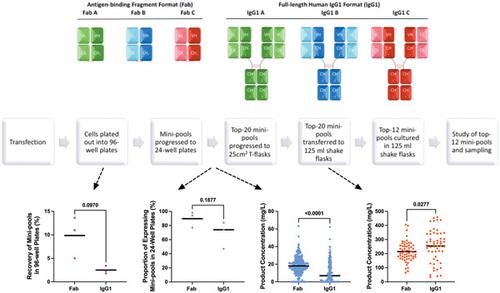当前位置:
X-MOL 学术
›
Biotechnol. Bioeng.
›
论文详情
Our official English website, www.x-mol.net, welcomes your
feedback! (Note: you will need to create a separate account there.)
A comparative analysis of recombinant Fab and full-length antibody production in Chinese hamster ovary cells
Biotechnology and Bioengineering ( IF 3.5 ) Pub Date : 2021-09-29 , DOI: 10.1002/bit.27944 Hirra Hussain 1, 2 , Tulshi Patel 3, 4 , Angelica M S Ozanne 3 , Davide Vito 3, 5 , Mark Ellis 6 , Matthew Hinchliffe 6 , David P Humphreys 6 , Paul E Stephens 6 , Bernie Sweeney 6, 7 , James White 6 , Alan J Dickson 1 , Christopher M Smales 3, 8
Biotechnology and Bioengineering ( IF 3.5 ) Pub Date : 2021-09-29 , DOI: 10.1002/bit.27944 Hirra Hussain 1, 2 , Tulshi Patel 3, 4 , Angelica M S Ozanne 3 , Davide Vito 3, 5 , Mark Ellis 6 , Matthew Hinchliffe 6 , David P Humphreys 6 , Paul E Stephens 6 , Bernie Sweeney 6, 7 , James White 6 , Alan J Dickson 1 , Christopher M Smales 3, 8
Affiliation

|
Monoclonal antibodies are the leading class of biopharmaceuticals in terms of numbers approved for therapeutic purposes. Antigen-binding fragments (Fab) are also used as biotherapeutics and used widely in research applications. The dominant expression systems for full-length antibodies are mammalian cell-based, whereas for Fab molecules the preference has been an expression in bacterial systems. However, advances in CHO and downstream technologies make mammalian systems an equally viable option for small- and large-scale Fab production. Using a panel of full-length IgG antibodies and their corresponding Fab pair with different antigen specificities, we investigated the impact of the IgG and Fab molecule format on production from Chinese hamster ovary (CHO) cells and assessed the cellular capability to process and produce these formats. The full-length antibody format resulted in the recovery of fewer mini-pools posttransfection when compared to the corresponding Fab fragment format that could be interpreted as indicative of a greater overall burden on cells. Antibody-producing cell pools that did recover were subsequently able to achieve higher volumetric protein yields (mg/L) and specific productivity than the corresponding Fab pools. Importantly, when the actual molecules produced per cell of a given format was considered (as opposed to mass), CHO cells produced a greater number of Fab molecules per cell than obtained with the corresponding IgG, suggesting that cells were more efficient at making the smaller Fab molecule. Analysis of cell pools showed that gene copy number was not correlated to the subsequent protein production. The amount of mRNA correlated with secreted Fab production but not IgG, whereby posttranscriptional processes act to limit antibody production. In summary, we provide the first comparative description of how full-length IgG and Fab antibody formats impact on the outcomes of a cell line construction process and identify potential limitations in their production that could be targeted for engineering increases in the efficiency in the manufacture of these recombinant antibody formats.
更新日期:2021-11-10











































 京公网安备 11010802027423号
京公网安备 11010802027423号